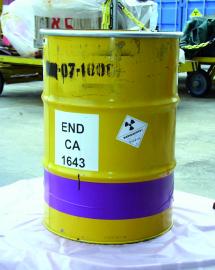Innovative concrete for the disposal of the most radioactive waste
 Supported by Andra within the framework of the Investments for the Future Program and selected within the framework of a call for projects with the National Research Agency (ANR), the MATRICE project aims to significantly reduce the quantity of hydrogen produced by the radiolysis of concrete contained in the long-lived medium-level radioactive waste (MA-VL) waste packages intended for storage in Cigeo. To do this, the project partners tested more than a hundred concrete formulas.
Supported by Andra within the framework of the Investments for the Future Program and selected within the framework of a call for projects with the National Research Agency (ANR), the MATRICE project aims to significantly reduce the quantity of hydrogen produced by the radiolysis of concrete contained in the long-lived medium-level radioactive waste (MA-VL) waste packages intended for storage in Cigeo. To do this, the project partners tested more than a hundred concrete formulas.
Some medium-level long-lived radioactive waste types (MA-VL) are mixed or blocked in concrete when packaged. Concrete thus serves as a binder when the waste is in the form of powders or sludge. It is a technique which also makes it possible to fill in the voids in certain types of metallic waste such as tubes or beams. This conditioning method ensures the stability of the packages over time and facilitates their handling. But water, naturally present in the “cement matrix”, base of concrete, can transform into hydrogen when it is exposed to the radiation emitted by waste. This is one of the main consequences of what is called "radiolysis of water".
Less water in packages helps reduce volume
Above a given concentration in an atmosphere containing oxygen, hydrogen may cause explosion when energy in the form of ultrasound, static electricity, shock, spark triggers a reaction. To prevent this risk, Andra is planning several protection measures in Cigeo, the deep geological disposal project intended to accommodate, among other things, MA-VL waste. First, Andra sets a maximum threshold for the hydrogen content produced by the packages it authorizes fir disposal, which producers must comply with. The ventilation of the cells during the operational phase of the disposal will limit the concentration of hydrogen and its accumulation. Multiple monitoring systems will verify that hyrogen concentration remains remains significantly below the thresholds above which hydrogen could pose a safety problem.

The cement manufacturer Vicat, the CEA and the company Léon Grosse have joined forces around the MATRICE project to propose concrete formulations that minimize the amount of hydrogen produced by radiolysis in waste packages. The objective is twofold: it is a question of limiting the potential production of hydrogen per package, while offering the possibility of incorporating more waste in each package, without reaching the specified production thresholds. A significant double benefit for Andra and the producers, as Xavier Bourbon, an expert in cement materials at Andra explains, who provides the interface with the various stakeholders in the project: "Deep geological storage is a scarce resource. Thanks to this type of concrete, the number of packages could be reduced for the same quantity of waste, therefore using less volume. MATRIX thus participates in responsible waste management. "
Since May 2016, the start date of the project, the three partners have been studying several avenues. The first consists in reducing the amount of water in the prepared concrete, while preserving its mechanical properties (solidity, resistance to compression, elasticity, etc.). But in this case, it is necessarily less fluid and the question arises of filling packages with such a material. In the case of homogeneous waste, intimately mixed with the hydraulic binder, a compaction process, by subjecting the cement to vibrations, was tested. Another avenue, studied for heterogeneous waste, consists in introducing chemical additives into the concrete, which increase its plasticity, for example, and thus decrease its water content. Finally, other technical solutions, using totally different binders, have been tested: sulfo-aluminous and phospho-magnesian cements. These two types of cements make it possible, in fact, to limit the total amount of water introduced in the cement mix and therefore ultimately the amount of water available for radiolysis.
Choose the right formulation
In almost four years, a hundred concrete formulations have already been tested. Only a few are selected today, as Xavier Bourbon explains: "The concrete formulations selected are those that significantly reduce the production of hydrogen. Tests were carried out in a CEA laboratory, where the samples were irradiated in order to assess the quantities of hydrogen produced. These innovative concretes must also meet mechanical performance criteria in order to guarantee the safety of the packages, in particular during handling operations. It must also be ensured that the raw materials used for the manufacture of these concretes are available on a large scale and that the process used can be industrialized. "

These are all elements that the Léon Grosse company, the MATRICE project owner must take into account: “Our role is to use the concrete formulations developed by the CEA and the Vicat cement manufacturer in order to ensure their implementation, to be able to move from the scale of the sample to that of an actual package of 200 liters, explains Guillaume Lobel, project coordinator at Leon Grosse. Increasing the amount of concrete to be produced requires adjustments to the basic formula. "
These innovative concretes are of interest both for producers, who dispose of radioactive waste, and for Andra, which takes charge of them for disposal. But other applications could emerge, particularly in the construction field, this time with an environmental challenge: the manufacture of these concretes produces less CO2 than those usually used.

